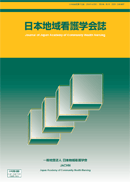Volume 20, Issue 2
Displaying 1-11 of 11 articles from this issue
- |<
- <
- 1
- >
- >|
Original Articles
-
2017Volume 20Issue 2 Pages 4-11
Published: 2017
Released on J-STAGE: August 20, 2018
Download PDF (1039K) -
2017Volume 20Issue 2 Pages 12-19
Published: 2017
Released on J-STAGE: August 20, 2018
Download PDF (1029K)
Research Reports
-
2017Volume 20Issue 2 Pages 20-28
Published: 2017
Released on J-STAGE: August 20, 2018
Download PDF (1017K) -
2017Volume 20Issue 2 Pages 29-37
Published: 2017
Released on J-STAGE: August 20, 2018
Download PDF (1050K) -
2017Volume 20Issue 2 Pages 38-45
Published: 2017
Released on J-STAGE: August 20, 2018
Download PDF (1046K) -
2017Volume 20Issue 2 Pages 46-54
Published: 2017
Released on J-STAGE: August 20, 2018
Download PDF (1026K) -
2017Volume 20Issue 2 Pages 55-63
Published: 2017
Released on J-STAGE: August 20, 2018
Download PDF (1085K) -
2017Volume 20Issue 2 Pages 64-72
Published: 2017
Released on J-STAGE: August 20, 2018
Download PDF (1023K)
Community Health Nursing Report
-
2017Volume 20Issue 2 Pages 73-79
Published: 2017
Released on J-STAGE: August 20, 2018
Download PDF (1018K)
Informations
-
2017Volume 20Issue 2 Pages 80-86
Published: 2017
Released on J-STAGE: August 20, 2018
Download PDF (1023K) -
2017Volume 20Issue 2 Pages 87-94
Published: 2017
Released on J-STAGE: August 20, 2018
Download PDF (1044K)
- |<
- <
- 1
- >
- >|
